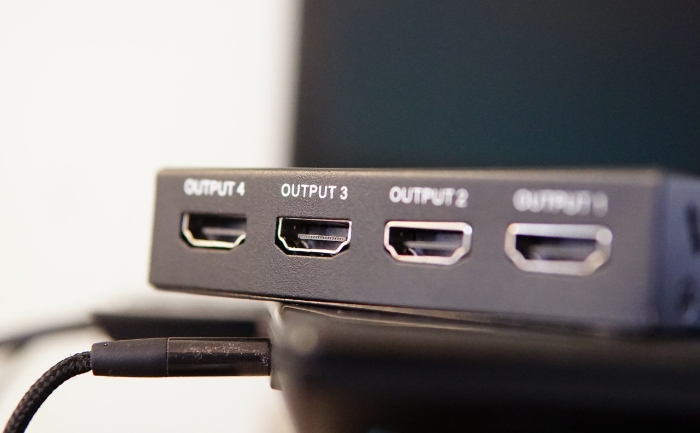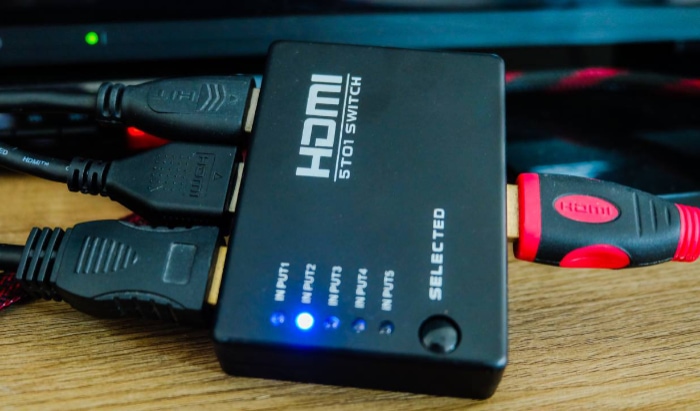HDMI Splitter vs. Switch: Simplifying Your Multimedia Maze

Setting up a home entertainment system or a professional audio-visual setup often leads to a common dilemma: choosing between an HDMI splitter and an HDMI switch. With many devices like gaming consoles, streaming sticks, and Blu-ray players vying for a spot on your TV or monitor, managing these connections efficiently becomes paramount.
HDMI technology, standing as the gold standard for transmitting high-definition audio and video signals, offers two clever solutions to address this challenge.
HDMI Splitters Explained
HDMI splitters play a crucial role in audiovisual setups where the same content needs to be displayed on multiple screens simultaneously. These devices are invaluable in both commercial settings like sports bars or educational environments and for home users wanting to extend their viewing experiences across several displays.
What Are HDMI Splitters?
An HDMI splitter is a device that takes a single HDMI input signal and duplicates it, sending the same signal to two or more displays. This allows for the identical video and audio streams to be viewed in multiple locations without the need for separate source devices for each display.
How Do HDMI Splitters Work?
The operation of an HDMI splitter is relatively straightforward. Once connected to a source device, such as a Blu-ray player or a streaming device, the splitter distributes the incoming signal identically to all connected outputs.
It’s important to note that splitters do not diminish the quality of the audio or video, meaning each display connected through the splitter should show a mirror image of the source.
Common Uses of HDMI Splitters
HDMI splitters are perfect for scenarios where the same content needs to be shown across different screens. This is commonly seen in public venues, classrooms, and even in homes where there’s a desire to watch the same movie or show on multiple televisions within the house.
Pros and Cons of Using an HDMI Splitter
Advantages
- Simplicity: HDMI splitters are easy to set up and use, requiring minimal technical knowledge.
- Quality Preservation: They maintain the audio and video quality of the source signal across all displays.
- Cost-Effective: Using a splitter is often more economical than purchasing additional source devices for each display.
Disadvantages
- Limited Functionality: Splitters only duplicate signals and cannot send different signals to different screens.
- Power Requirements: Some splitters need an external power source to function, which can add to the clutter and complexity of your setup.
- Potential Compatibility Issues: Not all splitters support the latest HDMI standards or features like HDCP 2.2, which can lead to compatibility problems with newer devices or content.
HDMI Switches Uncovered
In the realm of audiovisual setups, HDMI switches serve as a critical solution for managing multiple source devices on a single display. This is especially useful for users with more devices than their TV or monitor can directly support.
From gaming enthusiasts with multiple consoles to professionals requiring several computing devices connected to one monitor, HDMI switches simplify the complexity of modern multimedia setups.
What Are HDMI Switches?
HDMI switches are devices designed to connect multiple source devices to a single HDMI input on a TV or monitor. Unlike splitters that duplicate a signal across several screens, switches allow you to choose which device's signal is displayed at any given time.
This makes them ideal for expanding the connectivity of a display without the constant need to manually plug and unplug devices.
How HDMI Switches Operate
The core functionality of an HDMI switch is relatively simple: it routes the audio and video signal from one of several input sources to a single output. Most switches come with a button to manually select the active input source, though some models offer remote control for added convenience.
Advanced switches can automatically switch to the active input, further simplifying the user experience.
Typical Uses for HDMI Switches
HDMI switches are invaluable in setups where the number of source devices exceeds the available inputs on a display. They are commonly used in home entertainment systems for connecting multiple gaming consoles, streaming devices, and Blu-ray players to a single TV.
Professional settings, such as conference rooms and multimedia setups, also benefit from the versatility HDMI switches provide.
Advantages and Disadvantages of Using an HDMI Switch
Advantages
- Convenience: Switches make it easy to manage multiple devices without the hassle of swapping cables.
- Space Saving: They help maintain a clean and organized setup by reducing cable clutter.
- Support for High-Quality Signals: Modern HDMI switches support high resolutions and advanced features like 4K, HDR, and more.
Disadvantages
- Manual Switching: Some models require manual selection of the input source, which can be a minor inconvenience.
- Power Requirements: Like splitters, certain switches need an external power source to operate.
- Potential Signal Degradation: Although rare, some switches may introduce a slight delay or degradation in signal quality, especially in setups pushing the limits of the switch's capabilities.
Comparing HDMI Splitters and Switches

When setting up an audiovisual system, choosing between an HDMI splitter and an HDMI switch is a common crossroad. While both devices serve the purpose of optimizing your HDMI setup, they cater to different needs and scenarios.
Functionality and Use Case
HDMI splitters and switches differ primarily in their functionality. Splitters are designed to duplicate a single HDMI signal across multiple displays, allowing the same content to be shown on several screens simultaneously.
This is ideal for environments where the same output needs to be distributed, such as in digital signage setups or multi-room entertainment systems.
On the other hand, HDMI switches are built to connect multiple source devices to a single display, enabling users to select which source is active at any given time. They are perfect for setups with limited HDMI inputs on the display device but a need to connect multiple source devices, like game consoles or streaming boxes.
Compatibility and Resolution Support
Both HDMI splitters and switches generally support high-resolution video and audio. However, it's essential to verify that the device you choose is compatible with the specific HDMI version of your source devices and display.
For example, if you have 4K HDR content, you'll need a splitter or switch that supports HDMI 2.0 or higher to ensure the signal's integrity.
Pros and Cons
HDMI Splitters
- Pros:
- Allows simultaneous display of content on multiple screens.
- Easy to set up and operate.
- Cons:
- Cannot display different content on connected screens.
- Some models may require external power.
HDMI Switches
- Pros:
- Expands the number of HDMI sources that can be connected to a single display.
- Often supports automatic switching based on active input.
- Cons:
- Only one source can be displayed at a time.
- Manual switching might be necessary if automatic switching is not supported.
Selecting the Right Device for Your Needs
Choosing between an HDMI splitter and switch is a decision that hinges on the specific requirements of your audiovisual setup.
Evaluating Your Setup Requirements
Before making a decision, take a moment to assess the needs of your current or planned audiovisual setup. Consider the number of devices you wish to connect, the number of displays you intend to use, and how you plan to use them.
Are you looking to show the same content on multiple screens, or do you need to switch between different source devices on a single display? Your answer to these questions will significantly influence whether a splitter or a switch is the right choice for you.
Considering Future Expansion
Think about not just your current setup but also potential future changes. Will you be adding more devices or displays down the line? Selecting a device that can accommodate future expansion can save you from having to purchase additional equipment later.
For instance, opting for a switch with more inputs than you currently need offers flexibility as your system grows.
Understanding Device Specifications
Pay close attention to the technical specifications of both HDMI splitters and switches. Look for compatibility with the HDMI version used by your devices, support for the resolutions you intend to use (such as 4K or 8K), and any additional features like HDR, 3D, or audio return channel (ARC).
These specifications are crucial to ensuring that the device you choose can deliver the performance and quality you expect.
Balancing Quality with Budget
While it's important to choose a device that meets your technical requirements, budget constraints also play a significant role in the decision-making process. High-quality devices that support the latest standards and features typically come at a higher cost.
Determine what features are must-haves for your setup and what you can compromise on to find a balance between quality and affordability.
Reading Reviews and Seeking Recommendations
Lastly, leverage the experiences of others who have faced similar decisions. Reading product reviews and seeking recommendations from forums, social media groups, or platforms like Reddit can provide valuable insights into the reliability and performance of different HDMI splitters and switches.
Real-world feedback can help you narrow down your options and choose a device that has been tested and approved by users with similar needs.
Conclusion
Selecting the right HDMI device, be it a splitter or switch, significantly impacts the quality and functionality of your audiovisual setup.
HDMI splitters excel in environments where the same content needs mirroring across multiple displays, while HDMI switches are ideal for managing numerous source devices on a single screen. By considering factors like setup requirements, future expansion, device specifications, budget, and leveraging insights from product reviews and communities such as Reddit, you can make an informed decision that aligns with your needs.
Finally, the choice between an HDMI splitter and switch rests on understanding how each device fits within the context of your specific audiovisual aspirations, ensuring a seamless and enjoyable multimedia experience.


